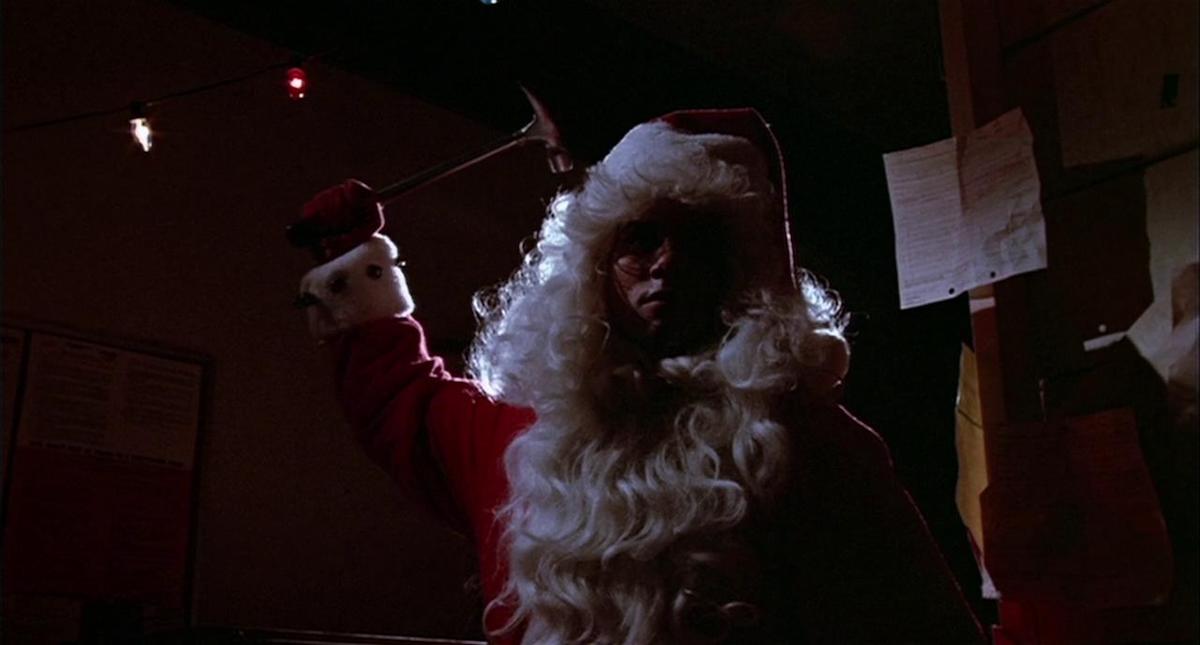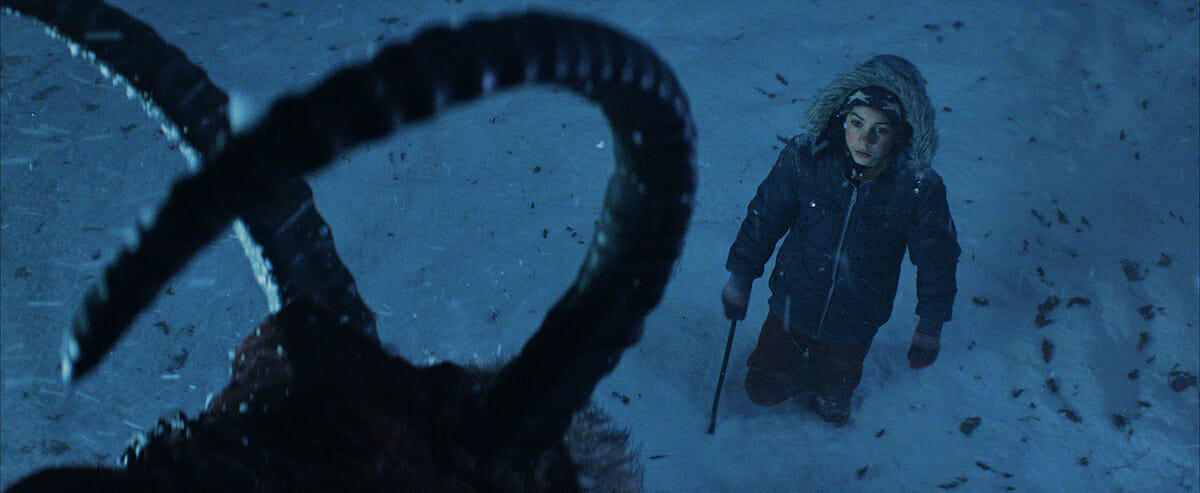Last year, I convinced my entire family to watch Silent Night, Deadly Night on Christmas Eve. I’ve been a fan of the campy cult classic ever since I watched it in college, and I wanted to share the joy with my loved ones. But it was after my stepmom’s second quiet utterance of “Oh my…” (sometime between Santa ripping off a woman’s blouse and slitting her throat) that I began to wonder why movies like this even exist—and why I, among many others, love them so damn much.
Turns out, Christmas and horror have always gone hand in hand. Several centuries before the birth of Jesus, early Europeans would celebrate the December solstice by gathering around a Yule log and sharing tales of winter, death, and rebirth. This tradition of swapping ghost stories was one of many pagan traditions co-opted by Christians, lasting well through the days of Victorian England. (As Andy Williams famously croons: “There’ll be scary ghost stories and tales of the glories of Christmases long, long ago.”)
The most famous Christmas ghost story is, of course, A Christmas Carol, which Charles Dickens published in 1843. The tale of Ebeneezer Scrooge’s moral reformation, courtesy of the spirits of Christmas Past, Present, and Yet to Come, is now a paradigm of the importance of charity during the holidays. It’s also pretty creepy—a fact that’s easy to forget in the wake of Jim Carrey and Muppet remakes.
In the story’s climax, the Ghost of Christmas Yet to Come shows Scrooge a terrifying glimpse of his future: He will become consumed by earthly possessions, die alone, and get sent straight to hell…unless he changes his ways right now. And therein lies the guilt-based root of most subsequent Christmas mythology—if you are nice, you’ll be rewarded; if you are naughty, you’ll be punished. The consequences of Santa’s punishment (a lump of coal) versus God’s punishment (eternal damnation) may be a little different, but the concepts are eerily similar.
It’s little wonder, then, that “Christmas horror” has evolved into a veritable subgenre over the past 50 years or so. The ghostly roots of holiday storytelling and religious standards of punishment lend themselves perfectly to the screen—as does the simple fact that the holidays aren’t exactly a holly jolly paradise for everyone. Christmas may be touted as a time of family gatherings and piles of presents, but it also is a season of loneliness, grief, and increased suicide rates. (As Phoebe Cates morbidly points out in Gremlins: “While everybody else is opening up their presents, they’re opening up their wrists.”) For those of us who feel excluded from the collective worship of Christmas, there’s definitely a sick relief in watching the holiday play out on screen as even more horribly than it does in our minds.
So how exactly did the genre begin? As with most horror benchmarks, this history lesson begins in the 70s…
He sees you when you’re sleeping…
The early 1970s brought about a few horror films set during the holidays, like Whoever Slew Auntie Roo? (1971) and Silent Night, Bloody Night (1972). But it wasn’t until Black Christmas in 1974 that people really started paying attention to Christmas horror. Directed by Bob Clark (who would go on to direct A Christmas Story nine years later), this Canadian thriller follows a group of girls gathered in their sorority house over the holidays. They begin to receive obscene phone calls from an unseen assailant named “Billy,” then slowly start getting killed off one by one until the film’s shocking conclusion.
Not only did Black Christmas pave the way for mainstream Christmas horror to come, but it is also considered one of the first slasher movies—the opening scene shot from the killer’s point of view found a particular fan in John Carpenter. It is filled with moments that would be recreated ad infinitum over the next half-century (“the call is coming from inside the house”), as well as a few details that remain completely unique (a pregnant Final Girl!). And although “phone calls from the killer” is now an eye-rollingly familiar cliche, the sickening calls from Billy make Ghostface’s threats sound like an episode of Crank Yankers.
Clark makes good use of the holiday season to create an atmosphere of terror, from the garish glow of Christmas lights to choral versions of “Silent Night” that are way creepier than any screechy score could ever hope to be; but aside from its diagetic elements, Black Christmas never really bastardizes the childlike innocence of the holiday—no killer Santas, no using tree toppers as murder weapons. That would all come later.
He knows when you’re awake…
By the time the 80s rolled around, slasher horror was a staple of mainstream cinema. Perhaps that’s why some of the early Christmas horror flicks of the decade were relegated to the background—or maybe it’s because they were really, really bad. The triple punch of To All a Goodnight (1980), Christmas Evil (1980), and Don’t Open Till Christmas (1984) now sits firmly in the zeitgeist of cult horror, but the films were sparsely viewed and widely panned at the time of their release.
Still, they served an important purpose in laying the groundwork for one of Christmas horror’s finest inventions—Killer Santa. The plot template established by these movies should look pretty familiar: A young boy witnesses a sexual encounter involving someone dressed as Santa. The boy grows up to become a socially awkward man. The man dons a Santa suit to dole out punishments based on his perverted concepts of “naughty” and “nice.” Roll credits.
All three films touch on this concept in some way or another, but nothing compares to the notoriety of Silent Night, Deadly Night (1984). Even before the film hit theaters, it received a flurry of controversy-fueled publicity. The trailer had to be pulled from airwaves after a string of protests, with parents claiming their children couldn’t sleep after seeing images of Santa carrying an axe. Then while reviewing the film, Gene Siskel announced with solemn chagrin, “Silent Night, Deadly Night now has the distinction of joining I Spit on Your Grave as one of the two most contemptible films I’ve seen,” before naming each of the filmmakers, shaming them, and calling their profits blood money.
Here’s the plot that launched a million tirades: As a young child, Billy watches a man dressed as Santa Claus assault his mother and murder both his parents on the side of a highway. He ends up in an orphanage, where a strict Mother Superior dismisses his trauma and whips sexually active teens with a belt. When he turns 18, he gets a job at a toy store (of course), where the manager asks him to dress up as Santa to greet children on Christmas Eve. This triggers all of Billy’s repressed memories, and he goes on a killing spree with a box cutter and axe.
After impaling girls on deer antlers and decapitating boys with his axe, Billy eventually makes his way back to the orphanage, where he attempts to kill Mother Superior before a cop shoots him in the back. “You’re safe now. Santa Claus is gone,” he whispers to the orphans with his dying breath. It’s a truly magical moment.
What’s interesting to note in Silent Night, Deadly Night—and this applies to most Killer Santa movies—is that Billy truly believes he has the moral high ground, doling out punishments based on his steadfast, albeit warped, sense of justice. He only murders the girl on deer antlers after watching her have premarital sex, and he only kills the boy on the sled after watching him bully another kid. The idea of emasculated men with a God complex (er, Santa complex?) is one that is ripe for a modern update, especially in this age of gun-wielding incels and alt-right vigilantes. I imagine the 2021 iteration of Billy would join Tinder, only to berate women for being sluts and never going after “nice guys” like him.
He knows if you’ve been bad or good…
I’d be remiss not to briefly touch on the other huge Christmas film of 1984: Gremlins. This Steven Spielberg vehicle tells the story of a white dude buying a furry mogwai from a Chinese pawn shop, which ends up ruining the town due to his son’s blatant disregard for simple rules. It’s not really a horror movie by most standards, but there are some seriously dark moments scattered throughout. (Mogwai in a microwave, anyone?)
Rather than a true benchmark of Christmas horror, Gremlins was really more of a harbinger of semi-dark holiday movies to come. The following decade would welcome A Nightmare Before Christmas, an obvious film on the cusp of childhood wonder and terror; but it would also bring about holiday comedies like Scrooged, National Lampoon’s Christmas Vacation, and Home Alone. They’re not horror movies, but they certainly touch upon ubiquitously dark elements like religious guilt, family discord, and Joe Pesci cutting off children’s ears with a knife.
Aside from these hits, the 90s were a relative wasteland of both Christmas blockbusters and Christmas horror movies. What we got instead was a slew of second-rate sequels and straight-to-video clonkers. In 1990, Silent Night, Deadly Night 4: Initiation dropped the killer Santa concept entirely to focus on a coven of witches, while Silent Night, Deadly Night 5: The Toy Maker (1991) stars Mickey Rooney as a crazed toy store owner who may or may not also be a robot.
We then got Jack Frost in 1997, a horror-comedy that is neither scary nor funny, but still manages to basically feel like a Criterion classic compared to the Christmas horror films of the 2000s. Take Gingerdead Man (2005), for example, which stars Gary Busey as a death-row serial killer whose ashes are thrown into gingerbread mix to create the titular mutant. The film was denounced by critics, but still went on to spawn a series of lousy, yet brilliantly titled sequels: Gingerdead Man 2: Passion of the Crust (2007), Gingerdead Man 3: Saturday Night Cleaver (2011), and Gingerdead Man vs. Evil Bong (2013). Even Busey was smart enough to stay away from all three.
So be good for goodness sake.
Just when it looked like holiday horror was on an eternal trajectory of garbage, the 2010s hit. The decade brought about a sort of renaissance of actually good (or at least ironically bad) horror movies, and the Christmas horror subgenre was no exception. We were ushered into the era by films like Rare Exports: A Christmas Tale (2010), a Finnish flick about a government research team who unleashes the evil origins of Santa, and Sint (2010), a Dutch movie that depicts St. Nicholas as a bishop who kills children all across Amsterdam.
However, neither of those films would go on to define the decade as well as Krampus (2015), another spin on Scandinavian folklore. Helmed by an actually competent director (Michael Dougherty of Trick ‘r Treat fame), the movie’s action starts when a young boy gets fed up with his squabbling family and denounces the spirit of Christmas. His anti-holiday sentiments conjure Krampus and his crew of gingerbread men, who terrorize Max’s family with hellmouths and demonic Jack-in-the-boxes.
That brings us to Christmas Horror Present. Since Krampus, we’ve gotten at least one solid addition to the genre almost every year: Better Watch Out (2016), Anna and the Apocalypse (2017), Slay Belles (2018), The Lodge (2019), The Advent Calendar (2020). Directors have seemed to finally nail the secret formula of dark humor, legitimate scares, and ridiculous repurposing of Christmas customs, all to the delight of horror fans everywhere. Although the genre has beaten certain tropes to death with a snow shovel, there will always be fresh material as long as humans keep fighting, shopping, and threatening children with fictional morality police. Fingers crossed for an Elf on the Shelf horror movie in 2022.









